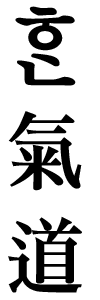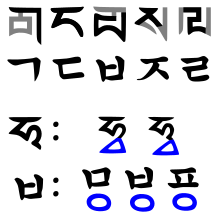Tungusic / Manchu-Tungus languages
Even,
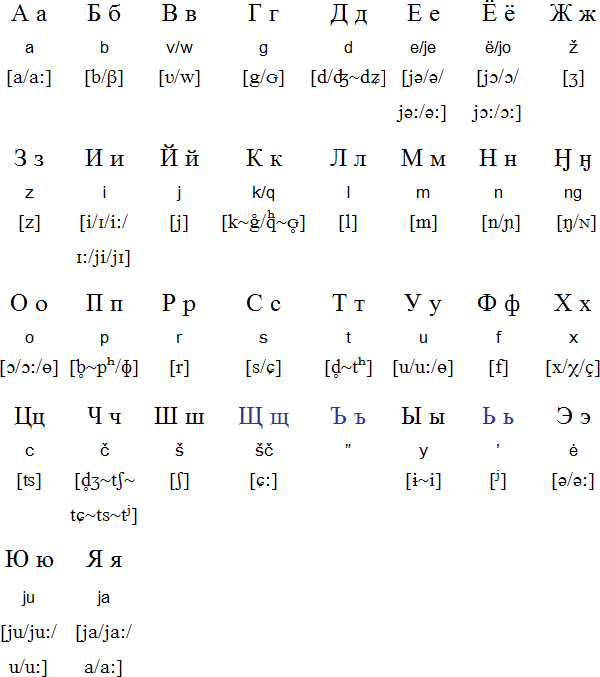
Nanai Alphabet
Nanai belongs to the Southern (Amur, or Nanai) branch of the Manchu-Tungus languages. It is spoken by about 5,000 speakers in Siberia, specifically in the Khabarovsk and Primorye territories, and in the Poronay district of the Sakhalin region of the Russia Federation. A slightly different dialect, known as Hezhen (赫哲语), is spoken along the Amur River in the North Eastern Chinese province of Heilongjiang (黑龙江).
---------------------------------------
Even belongs to the Siberian (or Evonkian) group of the Northern branch of the Manchu-Tungus languages. It is spoken by about 7,000 speakers in Siberia, specifically in the Magadan region, the Chukot and the Koryak autonomous areas, in some districts of the Khabarovsk territory and in the Republic of Yakutia (Sakha) in the North East of the Russian Federation.
Even alphabet
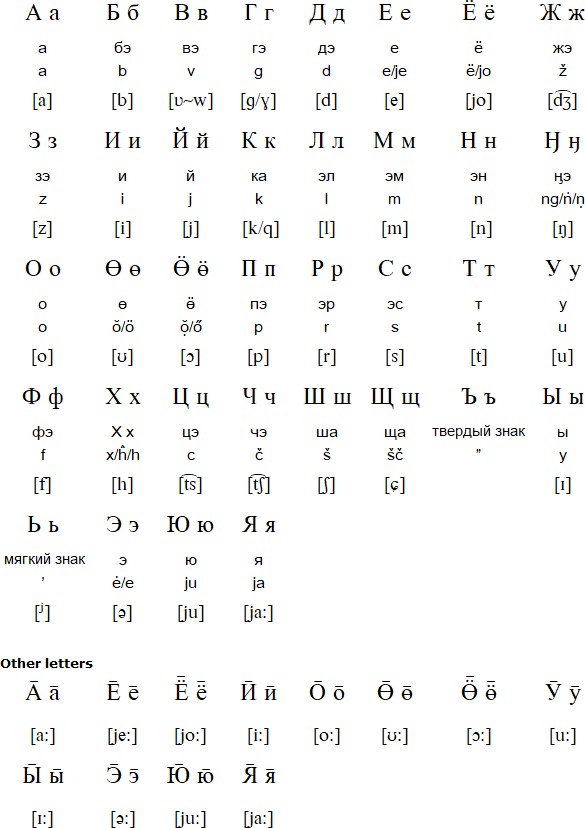
--------------------
Evenki is part of the Manchu-Tungus sub-group of Altaic languages and has about 20,000 speakers. It is spoken in the Evenki Autonomous District, or Evenkia (Эведы Автомоды Округ) in Russia, and also in parts of China and Mongolia. Approximately 45% of the Evenki people consider Evenki their mother tongue. Most of the speakers are elderly and the younger generation lack a thorough knowledge of the language. This is because until 1980 the Russian government tried to suppress the Evenki language, but since then Evenki has been taught in schools.
Evenki, which is also known as Evenk, Avenki, Avenk or Tungus, has much in common withMongolian and related languages. It has been strongly influenced by Yakut, Buryat and Russian.
Evenkia is the remotest inhabited part of Siberia. Until the 1930s, the Evenki people were mainly nomadic hunters and reindeer herders. Today hunting and reindeer herding are still important, but they are also involved in argriculture and industry.
The English word "shaman" comes from the Evenki word meaning "holy man".
Evenki alphabet (Cyrillic)
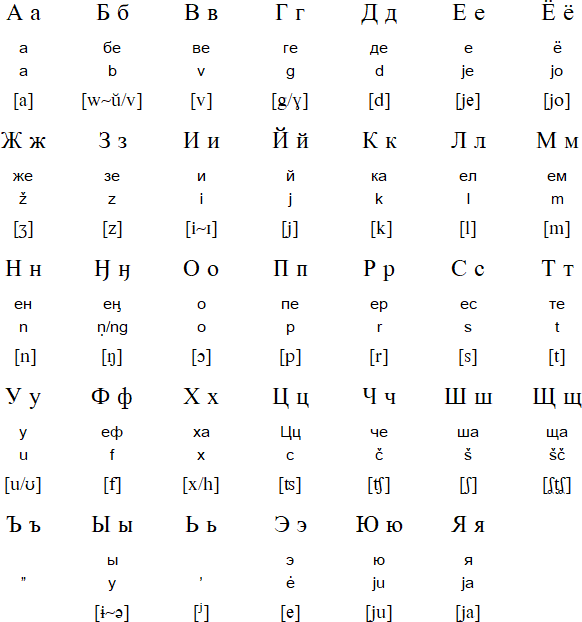
======
Evenki alphabet (Mongolian)
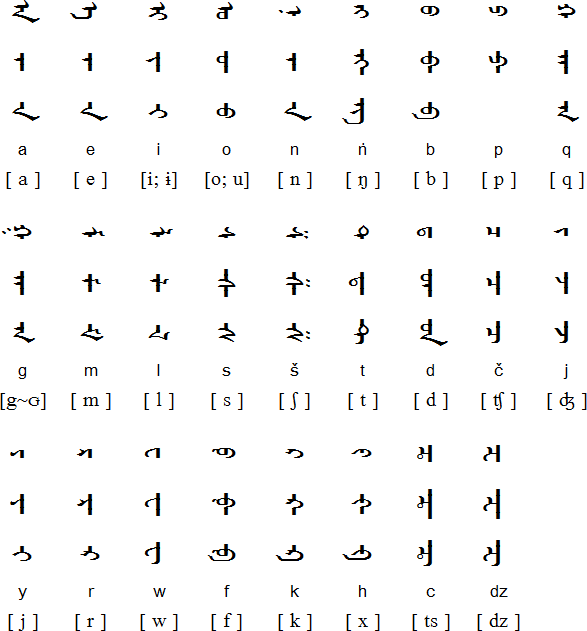
-------------
Origin
The Jurchen script, which is also known as Jurchi, Jurchin or Southern Tungusic, was created by Wanyan Xiyin in 1120 and officially introduced in 1145. It was modelled on the Khitan script and contains a large number of characters from Chinese, many of which were modified or distorted.
The script is known from fragments of manuscripts and inscriptions on monuments of the Jurchen empire, from the Sino-Jurchen glossary and documents of the Ming Bureau of Translators and from Ming inscriptions dating from 1413.
The Jurchen people lived in the northeast of Manchuria before the 12th century. Then in 1115 they conquered a large part of northern China, including the lands of the Khitan people, and set up the Jin dynasty. The Jin dynasty fell to the Mongols in 1234. The Jurchen people became known as Manchus in the 17th century when they conquered the whole of China and established the Qing dynasty (1680-1911).
Notable features
- According to the Sino-Jurchen glossary, the Jurchen script contains 720 characters - a mixture of logograms, which represent whole words without any phonetic element, and phonograms, which represent sounds. Compound words consisting of two or more characters were also used.
- The Jurchen characters have a system of radicals similar to Chinese characters and are ordered according to radical and stroke count.
Used to write
Jurchen/Manchu, a member of the Tungusic branch of the Altaic language family. There are currently about 9 million Manchus living in northeastern China, of whom between 70 and 1,000 speak Manchu. Most speak only Mandarin. In Chinese, this language is known as 女眞 [女真] (nǚzhēn).
In Xinjiang in the west of China there are about 27,000 people known as Sibe, Xibo or Sibo who speak a language closely related to Manchu, though they consider themselves a separte ethnic group. The Sibe were moved to the region in 1764 by the Ch'ing emperor Qianlong.
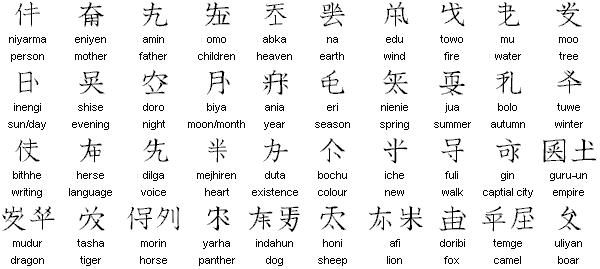
-----numbers in jurchen;
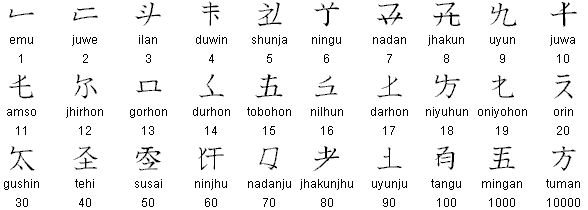
----------------http://www.omniglot.com/writing/manchu.htm
 Manchu alphabet
Manchu alphabet
The Manchu alphabet was commissioned in 1599 by the Manchu leader Nurhaci (1559-1626), the founder of the Manchu state. The letters are based on the Classical Mongolian alphabet while the phonetics are based on Jurchen, an earlier Manchu script. The alphabet was modified slightly in 1632.
In 1644 the Manchus conquered China and established the Ch'ing (Qing) dynasty, which lasted until 1911. For the first 200 years or so of the Ch'ing dynasty, Manchu was the main language of government in China and served as a lingua franca. By the mid 19th century many of the Manchus had adopted Chinese as their first language, however they continued to produce Manchu version of Chinese documents until the end of the dynasty and for sometime afterwards.
Used to write
Manchu, a member of the Tungusic group of Altaic languages. There are currently about 10 million Manchus living mainly in north-eastern China, of whom about 100 speak Manchu and only 20 can read and write it. Most speak only Mandarin.
A version of the Manchu script is used to write Xibe, a Tungusic language closely related to Manchu and spoken in Xinjiang in the north west of China by 30,000 people.
Manchu alphabet
Vowels
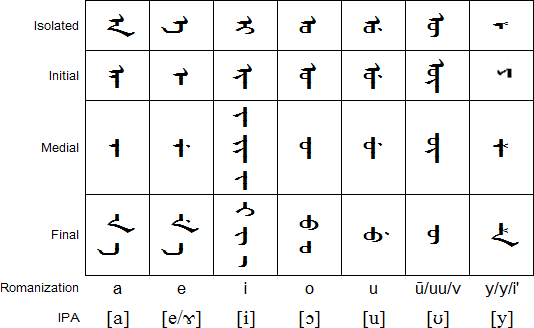
consonents
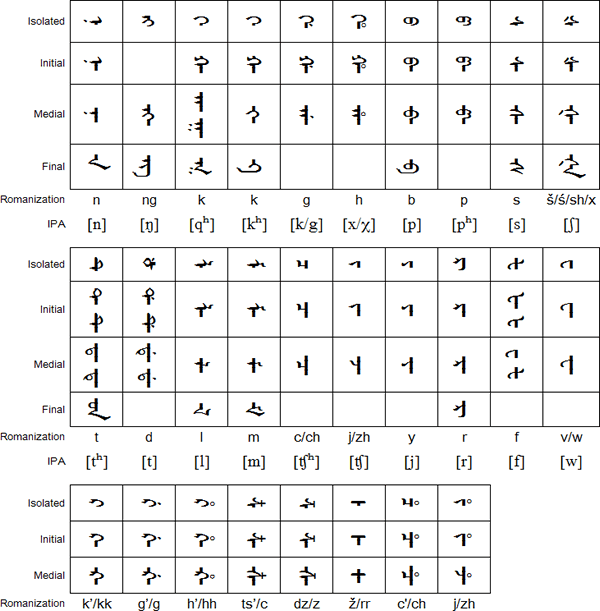
syllables;
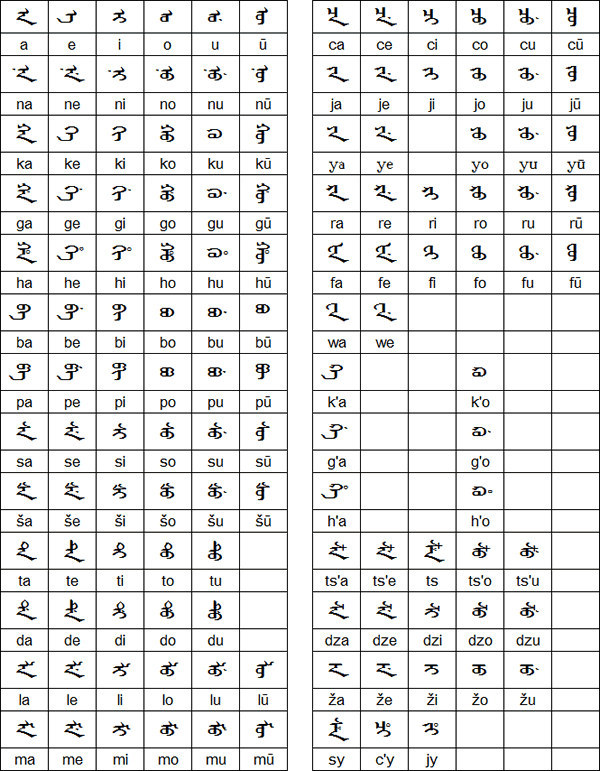

----------------
Orok belongs to the Northern branch of the Manchu-Tungus (Tungusic) languages. It is spoken by about 64 people in the Poronaysky and Nogliksky Administrative Divisions of Sakhalin Island in the Russian Federation. There are also some Oroks who live on Hokkaido island in Japan and maybe three of them speak Orok.
Orok is used as an everyday language by some members of the older generation of Orok people, and is taught in one school on Sakhalin. Since 2007 Orok has been written with a version of the Cyrillic alphabet, and an Orok primer has been published. A Japanese linguist, Professor Jiro Ikegami, developed the written form of Orok.
Orok alphabet
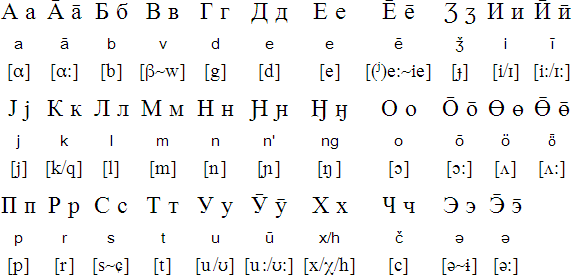
--------------
 Xibe
Xibe
Xibe is a Tungusic language spoken in Xinjiang Uyghur Autonomous Region in north west China by about 30,000 people. It is closely related to Manchu, though the Xibe people consider themselves a separte ethnic group. The Xibe were moved to the region in 1764 by the Ch'ing emperor Qianlong. The language is also known as Sibe, Xibo or Sibo.
Xibe is taught as a subject in a number of primary schools in Qapqal Xibe Autonomous County ( Cabcal Sibe beye dasangga siyan) in northern Xinjiang. It is also taught at Ili Normal University. A number of publications in Xibe were published between 1954 and 1959 by the People's Publishing House in Ürümqi. News in Xibe has been published in theQapqal News since 1946, there are short daily radio broadcasts in Xibe, and occasional television programmes.
Cabcal Sibe beye dasangga siyan) in northern Xinjiang. It is also taught at Ili Normal University. A number of publications in Xibe were published between 1954 and 1959 by the People's Publishing House in Ürümqi. News in Xibe has been published in theQapqal News since 1946, there are short daily radio broadcasts in Xibe, and occasional television programmes.
Xibe alphabet
Xibe is written with a version of the Manchu alphabet.
vowels;
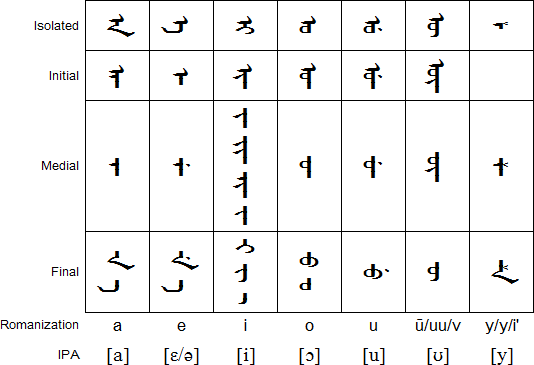
consonants;
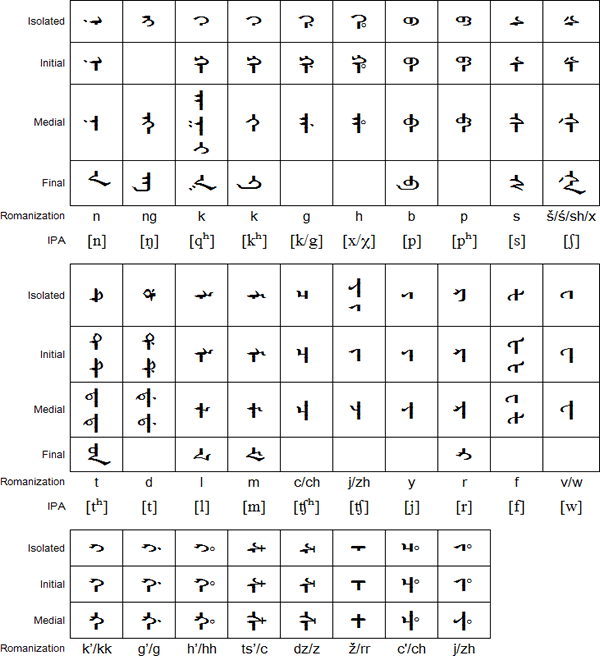
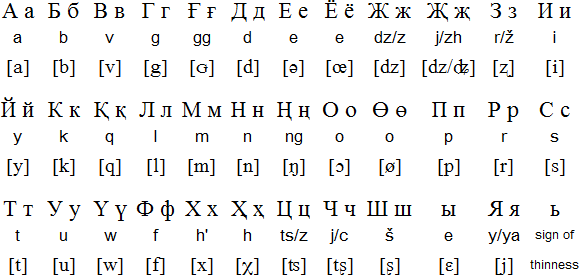
---------------------------- Original 1443 훈민정음Korean;

훈민정음
Historical orders[edit]
The consonantal order of the Hunmin Jeongeum in 1446 was,
- ㄱ ㅋ ㆁ ㄷ ㅌ ㄴ ㅂ ㅍ ㅁ ㅈ ㅊ ㅅ ㆆ ㅎ ㅇ ㄹ ㅿ
and the order of vowels was,
- ㆍ ㅡ ㅣ ㅗ ㅏ ㅜ ㅓ ㅛ ㅑ ㅠ ㅕ
- letters ㅇ (null) and ㆁ (ng).
- In 1527, Choe Sejin reorganized the alphabet:
- ㄱ ㄴ ㄷ ㄹ ㅁ ㅂ ㅅ ㆁ ㅋ ㅌ ㅍ ㅈ ㅊ ㅿ ㅇ ㅎ
- ㅏ ㅑ ㅓ ㅕ ㅗ ㅛ ㅜ ㅠ ㅡ ㅣ ㆍ
- with South Korea grouping similar letters together, and North Korea placing new letters at the end of the alphabet.
- S.korea;
- ㄱ ㄲ ㄴ ㄷ ㄸ ㄹ ㅁ ㅂ ㅃ ㅅ ㅆ ㅇ ㅈ ㅉ ㅊ ㅋ ㅌ ㅍ ㅎ
- ㅏ ㅐ ㅑ ㅒ ㅓ ㅔ ㅕ ㅖ ㅗ ㅘ ㅙ ㅚ ㅛ ㅜ ㅝ ㅞ ㅟ ㅠ ㅡ ㅢ ㅣ
-
- (none) ㄱ ㄲ ㄳ ㄴ ㄵ ㄶ ㄷ ㄹ ㄺ ㄻ ㄼ ㄽ ㄾ ㄿ ㅀ ㅁ ㅂ ㅄ ㅅ ㅆ ㅇ ㅈ ㅊ ㅋ ㅌ ㅍ ㅎ
("None" means there is no final letter.)N. Korea;ㄱ ㄴ ㄷ ㄹ ㅁ ㅂ ㅅ ㅈ ㅊ ㅋ ㅌ ㅍ ㅎ ㄲ ㄸ ㅃ ㅆ ㅉ ㅇㅏ ㅑ ㅓ ㅕ ㅗ ㅛ ㅜ ㅠ ㅡ ㅣ ㅐ ㅒ ㅔ ㅖ ㅚ ㅟ ㅢ ㅘ ㅝ ㅙ ㅞ(none) ㄱ ㄳ ㄴ ㄵ ㄶ ㄷ ㄹ ㄺ ㄻ ㄼ ㄽ ㄾ ㄿ ㅀ ㅁ ㅂ ㅄ ㅅ ㅇ ㅈ ㅊ ㅋ ㅌ ㅍ ㅎ ㄲ ㅆas follows:Consonant Name ㄱ giyeok (기역), or kiŭk (기윽) in North Korea ㄴ nieun/niŭn (니은) ㄷ digeut (디귿), or tiŭt (디읃) in North Korea ㄹ rieul/riŭl (리을) ㅁ mieum/miŭm (미음) ㅂ bieup/piŭp (비읍) ㅅ siot (시옷), or siŭt (시읏) in North Korea ㅇ ieung/iŭng (이응) ㅈ jieut/chiŭt (지읒) ㅊ chieut/ch'iŭt (치읓) ㅋ kieuk/k'iŭk (키읔) ㅌ tieut/t'iŭt (티읕) ㅍ pieup/p'iŭp (피읖) ㅎ hieut/hiŭt (히읗) All consonants in North Korea, and all but three in the morebieup with the hanja 非 bi 邑 eup. The names of g, d, and s are exceptions because there were no hanja for euk, eut, andeus. 役 yeok is used in place of euk. Since there is no hanja that ends in t or s, Choi chose two hanja to be read in their Korean gloss, 末 kkeut "end" and 衣 ot "clothes".Originally, Choi gave j, ch, k, t, p, and h the irregular one-syllable names of ji, chi, ki, ti, pi, and hi, because they should not be used as final consonants, as specified in Hunmin jeong-eum. But after the establishment of the new orthography in 1933, which allowed all consonants to be used as finals, the names were changed to the present forms.The double consonants are named with the word 쌍/雙 ssang, meaning "twin" or "double", or with 된 doen in North Korea, meaning "strong". Thus:Letter South Korean Name North Korean name ㄲ ssanggiyeok (쌍기역) toen'giŭk (된기윽) ㄸ ssangdigeut (쌍디귿) toendiŭt (된디읃) ㅃ ssangbieup (쌍비읍) toenbiŭp (된비읍) ㅆ ssangsiot (쌍시옷) toensiŭt (된시읏) ㅉ ssangjieut (쌍지읒) toenjiŭt (된지읒) In North Korea, an alternate way to refer to a consonant is by the name letter + ŭ (ㅡ), for example, 그 kŭ for the letter ㄱ, 쓰 ssŭ for the letter ㅆ, etc.Vowel names[edit]
The names of the vowel letters are simply the vowel itself, written with the null initial ㅇ ieung and the vowel being named. Thus:Letter Name Letter Name ㅏ a (아) ㅐ ae (애) ㅑ ya (야) ㅒ yae (얘) ㅓ eo (어) ㅔ e (에) ㅕ yeo (여) ㅖ ye (예) ㅗ o (오) ㅘ wa (와) ㅛ yo (요) ㅙ wae (왜) ㅚ oe (외) ㅜ u (우) ㅝ wo (워) ㅠ yu (유) ㅞ we (웨) ㅟ wi (위) ㅡ eu (으) ㅢ ui (의) ㅣ i (이) In the Seoul dialect of Modern Korean, e(ㅔ) and ae(ㅐ) have no distinction in pronunciation. For this reason they are denoted as eo-i(어-이) for e(ㅔ) and a-i(아-이) for ae(ㅐ) when giving the spelling of a word or name in spoken conversation.Obsolete letters[edit]
Several letters are obsolete. These include several that represent Korean sounds that have since disappeared from the standard language, as well as a larger number used to represent the sounds of the Chinese rime tables. The most frequently encountered of these archaic letters are:- ㆍ (transcribed ə (arae-a 아래아 "lower a"): Presumably pronounced [ʌ], similar to modern ㅓ eo. It is written as a dot, positioned beneath (Korean for "beneath" is arae) the consonant. The arae-a is not entirely obsolete, as it can be found in various brand names.
- The ə formed a medial of its own, or was found in the diphthong ㆎ arae-ae, written with the dot under the consonant and ㅣ (transcribed i) to its right – in the same fashion as ㅚ or ㅢ.
- ㅿ z (bansiot 반시옷): A rather unusual sound, perhaps IPA [ʝ̃] (a nasalized palatal fricative). Modern Korean words previously spelled with ㅿ substitute ㅅ or ㅇ.
- ㆆ ʔ (yeorinhieut 여린히읗 "light hieut" or doenieung 된 이응 "strong ieung"): A glottal stop, "lighter than ㅎ and harsher than ㅇ".
- ㆁ ŋ (yesieung 옛이응): The original letter for [ŋ]; now conflated with ㅇ ieung. (With some computer fonts such as Arial Unicode MS, yesieung is shown as a flattened version of ieung, but the correct form is with a long peak, longer than what one would see on a serif version of ieung.)
- ㅸ β (gabyeounbieup 가벼운비읍): IPA [f]. This letter appears to be a digraph of bieup andieung, but it may be more complicated than that. There were three other, less-common letters for sounds in this section of the Chinese rime tables, ㅱ w ([w] or [m]), a theoretical ㆄ f, and ㅹ ff [v̤]; the bottom element appears to be only coincidentally similar to ieung. However its exact shape, it operates somewhat like a following h in the Latin alphabet (one may think of these letters as bh, mh, ph, and pph respectively). Koreans do not distinguish these sounds now, if they ever did, conflating the fricatives with the corresponding plosives.
There were two other now-obsolete double letters,- ㆅ x (ssanghieut 쌍히읗 "double hieut"): IPA [ɣ̈ʲ] or [ɣ̈].
- ᅇ (ssang-ieung 쌍이응 "double ieung"): Another letter used in the Chinese rime table.
In the original Hangul system, double letters were used to represent Chinese voiced (濁音) consonants, which survive in the Shanghainese slack consonants, and were not used for Korean words. It was only later that a similar convention was used to represent the modern "tense" (faucalized) consonants of Korean.The sibilant ("dental") consonants were modified to represent the two series of Chinese sibilants, alveolar and retroflex, a "round" vs. "sharp" distinction (analogous to s vs sh) which was never made in Korean, and which was even being lost from southern Chinese. The alveolar letters had longer left stems, while retroflexes had longer right stems:Original consonants ㅅ ㅆ ㅈ ㅉ ㅊ Chidueum (alveolar sibilant) ᄼ ᄽ ᅎ ᅏ ᅔ Jeongchieum (retroflex sibilant) ᄾ ᄿ ᅐ ᅑ ᅕ There were also consonant clusters that have since dropped out of the language, such as the finals ㅴ bsg and ㅵ bsd, as well as diphthongs that were used to represent Chinese medials, such as ㆇ, ㆈ, ㆊ, ㆋ.Some of the Korean sounds represented by these obsolete letters still exist in some dialects.Unicode[edit]
See also: List of Hangul JamoMain articles: Hangul Syllables (Unicode block), Hangul Jamo (Unicode block), Hangul Jamo Extended-A (Unicode block), Hangul Jamo Extended-B (Unicode block), and Hangul Compatibility Jamo (Unicode block)Hangul Jamo (U+1100—U+11FF) and Hangul Compatibility Jamo (U+3130—U+318F) were added to the Unicode Standard in June 1993 with the release of version 1.1.Hangul Jamo Extended-A (U+A960—U+A97F) and Hangul Jamo Extended-B (U+D7B0—U+D7FF) were added to the Unicode Standard in October 2009 with the release of version 5.2.Hangul Jamo[1]
Unicode.org chart (PDF)0 1 2 3 4 5 6 7 8 9 A B C D E F U+110x ᄀ ᄁ ᄂ ᄃ ᄄ ᄅ ᄆ ᄇ ᄈ ᄉ ᄊ ᄋ ᄌ ᄍ ᄎ ᄏ U+111x ᄐ ᄑ ᄒ ᄓ ᄔ ᄕ ᄖ ᄗ ᄘ ᄙ ᄚ ᄛ ᄜ ᄝ ᄞ ᄟ U+112x ᄠ ᄡ ᄢ ᄣ ᄤ ᄥ ᄦ ᄧ ᄨ ᄩ ᄪ ᄫ ᄬ ᄭ ᄮ ᄯ U+113x ᄰ ᄱ ᄲ ᄳ ᄴ ᄵ ᄶ ᄷ ᄸ ᄹ ᄺ ᄻ ᄼ ᄽ ᄾ ᄿ U+114x ᅀ ᅁ ᅂ ᅃ ᅄ ᅅ ᅆ ᅇ ᅈ ᅉ ᅊ ᅋ ᅌ ᅍ ᅎ ᅏ U+115x ᅐ ᅑ ᅒ ᅓ ᅔ ᅕ ᅖ ᅗ ᅘ ᅙ ᅚ ᅛ ᅜ ᅝ ᅞ ᅟ U+116x ᅠ ᅡ ᅢ ᅣ ᅤ ᅥ ᅦ ᅧ ᅨ ᅩ ᅪ ᅫ ᅬ ᅭ ᅮ ᅯ U+117x ᅰ ᅱ ᅲ ᅳ ᅴ ᅵ ᅶ ᅷ ᅸ ᅹ ᅺ ᅻ ᅼ ᅽ ᅾ ᅿ U+118x ᆀ ᆁ ᆂ ᆃ ᆄ ᆅ ᆆ ᆇ ᆈ ᆉ ᆊ ᆋ ᆌ ᆍ ᆎ ᆏ U+119x ᆐ ᆑ ᆒ ᆓ ᆔ ᆕ ᆖ ᆗ ᆘ ᆙ ᆚ ᆛ ᆜ ᆝ ᆞ ᆟ U+11Ax ᆠ ᆡ ᆢ ᆣ ᆤ ᆥ ᆦ ᆧ ᆨ ᆩ ᆪ ᆫ ᆬ ᆭ ᆮ ᆯ U+11Bx ᆰ ᆱ ᆲ ᆳ ᆴ ᆵ ᆶ ᆷ ᆸ ᆹ ᆺ ᆻ ᆼ ᆽ ᆾ ᆿ U+11Cx ᇀ ᇁ ᇂ ᇃ ᇄ ᇅ ᇆ ᇇ ᇈ ᇉ ᇊ ᇋ ᇌ ᇍ ᇎ ᇏ U+11Dx ᇐ ᇑ ᇒ ᇓ ᇔ ᇕ ᇖ ᇗ ᇘ ᇙ ᇚ ᇛ ᇜ ᇝ ᇞ ᇟ U+11Ex ᇠ ᇡ ᇢ ᇣ ᇤ ᇥ ᇦ ᇧ ᇨ ᇩ ᇪ ᇫ ᇬ ᇭ ᇮ ᇯ U+11Fx ᇰ ᇱ ᇲ ᇳ ᇴ ᇵ ᇶ ᇷ ᇸ ᇹ ᇺ ᇻ ᇼ ᇽ ᇾ ᇿ Notes - 1.^ As of Unicode version 6.3
- 2. ᄀ: Hangul jamo with a green background are modern-usage characters which can be converted into precomposed Hangul syllables under Unicode normalization form NFC. Hangul jamo with a white background are used for archaic Korean only, and there are no corresponding precomposed Hangul syllables. "Conjoining Jamo Behavior". The Unicode Standard (version 6.0.0). Retrieved 2012-02-03.
- 1.^ As of Unicode version 6.3
Hangul Compatibility Jamo[1]
Unicode.org chart (PDF)0 1 2 3 4 5 6 7 8 9 A B C D E F U+313x ㄱ ㄲ ㄳ ㄴ ㄵ ㄶ ㄷ ㄸ ㄹ ㄺ ㄻ ㄼ ㄽ ㄾ ㄿ U+314x ㅀ ㅁ ㅂ ㅃ ㅄ ㅅ ㅆ ㅇ ㅈ ㅉ ㅊ ㅋ ㅌ ㅍ ㅎ ㅏ U+315x ㅐ ㅑ ㅒ ㅓ ㅔ ㅕ ㅖ ㅗ ㅘ ㅙ ㅚ ㅛ ㅜ ㅝ ㅞ ㅟ U+316x ㅠ ㅡ ㅢ ㅣ ㅤ ㅥ ㅦ ㅧ ㅨ ㅩ ㅪ ㅫ ㅬ ㅭ ㅮ ㅯ U+317x ㅰ ㅱ ㅲ ㅳ ㅴ ㅵ ㅶ ㅷ ㅸ ㅹ ㅺ ㅻ ㅼ ㅽ ㅾ ㅿ U+318x ㆀ ㆁ ㆂ ㆃ ㆄ ㆅ ㆆ ㆇ ㆈ ㆉ ㆊ ㆋ ㆌ ㆍ ㆎ Notes - 1.^ As of Unicode version 6.3
Hangul in other Unicode blocks:Two obsolete letters were restored: <ㅿ> (리읃), which was used to indicate an alternation in pronunciation between initial /l/ and final /d/; and <ㆆ> (히으), which was only pronounced between vowels. Two modifications of the letter ㄹ were introduced, one for a ㄹ which is silent finally, and one for a ㄹ which doubled between vowels. A hybrid ㅂ-ㅜ letter was introduced for words which alternated between those two sounds (that is, a /b/ which became /w/ before a vowel). Finally, a vowel <1> was introduced for variable iotation.Morpho-syllabic blocks[edit]
Except for a few grammatical morphemes prior to the twentieth century, no letter may stand alone to represent elements of the Korean language. Instead, letters are grouped into syllabic or morphemic blocks of at least two and often three: (1) a consonant or a doubled consonant called the initial (초성, 初聲 choseongsyllable onset), (2) a vowel or diphthong called the medial (중성, 中聲 jungseongsyllable nucleus), and, optionally, (3) a consonant or consonant cluster at the end of the syllable, called the final (종성, 終聲 jongseong syllable coda). When a syllable has no actual initial consonant, the null initial ㅇ ieung is used as a placeholder. (In modern Hangul, placeholders are not used for the final position.) Thus, a block contains a minimum of two letters, an initial and a medial. Although the Hangul had historically been organized into syllables, in the modern orthography it is first organized into morphemes, and only secondarily into syllables within those morphemes, with the exception that single-consonant morphemes may not be written alone. (See Orthography.)The sets of initial and final consonants are not the same. For instance, ㅇ ng only occurs in final position, while the doubled letters that can occur in final position are limited to ㅆ ss and ㄲ kk. For a list of initials, medials, and finals, seeHangul consonant and vowel tables.Not including obsolete letters, there are 11,172 possible Hangul blocks.Letter placement within a block[edit]
The placement or "stacking" of letters in the block follows set patterns based on the shape of the medial.- Consonant and vowel sequences such as ㅄ bs, ㅝ wo, or obsolete ㅵbsd, ㆋ üye are written left to right.
- Vowels (medials) are written under the initial consonant, to the right, or wrap around the initial from bottom to right, depending on their shape: If the vowel has a horizontal axis like ㅡ eu, then it is written under the initial; if it has a vertical axis like ㅣ i, then it is written to the right of the initial; and if it combines both orientations, like ㅢ ui, then it wraps around the initial from the bottom to the right:
initial medial initial medial initial med.
2med. 1 - A final consonant, if there is one, is always written at the bottom, under the vowel. This is called 받침 batchim"supporting floor":
initial medial final initial medial final initial med.
2med. final - A complex final is written left to right:
initial medial final 1 final 2 initial medial final 1 final 2 initial med.
2med. fin. 1 fin. 2 Blocks are always written in phonetic order, initial-medial-final. Therefore,- Syllables with a horizontal medial are written downward: 읍 eup;
- Syllables with a vertical medial and simple final are written clockwise: 쌍 ssang;
- Syllables with a wrapping medial switch direction (down-right-down): 된 doen;
- Syllables with a complex final are written left to right at the bottom: 밟 balp.
Block shape[edit]
Normally the resulting block is written within a square of the same size and shape as a hanja (Chinese character) by compressing or stretching the letters to fill the bounds of the block; therefore someone not familiar with the scripts may mistake Hangul text for hanja or Chinese text.However, some recent fonts (for example Eun, HY깊은샘물M, UnJamo) move towards the European practice of letters whose relative size is fixed, and the use of whitespace to fill letter positions not used in a particular block, and away from the East Asian tradition of square block characters (方块字). They break one or more of the traditional rules:- Do not stretch initial consonant vertically, but leave white space below it if no lower vowel and/or no final consonant.
- Do not stretch right-hand vowel vertically, but leave white space below it if no final consonant. (Often the right-hand vowel extends farther down than the left-hand consonant, like a descender in European typography)
- Do not stretch final consonant horizontally, but leave white space to left of it.
- Do not stretch or pad each block to be a fixed width, but allow variable width (kerning) where syllable blocks with no right-hand vowel and no double final consonant can be narrower than blocks that do have a right-hand vowel or double final consonant.
So far, these fonts have been used as design accents on signs or headings, rather than for typesetting large volumes of body text.Linear hangul[edit]
There was a minor and unsuccessful movement in the early twentieth century to abolish syllabic blocks and write the letters individually and in a row, in the fashion of the European alphabets: e.g. ㅎㅏㄴㄱㅡㄹ for 한글 hangeul.[33]Avant-garde typographer Ahn Sangsu made a font for the "Hangul Dada" exposition that exploded the syllable blocks; but while it strings out the letters horizontally, it retains the distinctive vertical position each letter would normally have within a block, unlike the century-old linear writing proposals.[34]While Koreans have largely accepted the European-derived conventions of writing successive syllables left-to-right in horizontal lines instead of in vertical columns, adding spaces between words, and European-style punctuation, they have completely resisted getting rid of syllabic blocks,[citation needed] the most distinctive feature of this writing system.Orthography[edit]
Until the 20th century, no official orthography of hangul had been established. Due to liaison, heavy consonant assimilation, dialectical variants and other reasons, a Korean word can potentially be spelled in various ways. King Sejong seemed to prefer morphophonemic spelling (representing the underlying root forms) rather than a phonemic one (representing the actual sounds). However, early in its history, Hangul was dominated by phonemic spelling. Over the centuries the orthography became partially morphophonemic, first in nouns, and later in verbs. Today it is as morphophonemic as is practical. The difference between phonetic Romanization, phonemic orthography, and morpho-phonemic orthography can be illustrated with the phrase motaneun sarami:- Phonetic transcription and translation:
- motaneun sarami
- [mo.tʰa.nɯn.sa.ɾa.mi]
- a person who cannot do it
- Phonemic transcription:
- 모타는사라미
- /mo.tʰa.nɯn.sa.la.mi/
- Morphophonemic transcription:
- 못하는사람이
- |mot-ha-nɯn-sa.lam-i|
- Morpheme-by-morpheme gloss:
못–하–는 사람=이 mot-ha-neun saram=i cannot-do-[attributive] person=[subject] - Comparison of phonemic and modern morpho-phonemic orthographies:
- 모타는사라미
- 못하는 사람이
After the Gabo Reform in 1894, the Joseon Dynasty and later the Korean Empire started to write all official documents in Hangul. Under the government's management, proper usage of Hangul and hanja, including orthography, was discussed, until Korean Empire was annexed by Japan in 1910.The Government-General of Korea popularized the writing style of a mixture of hanja and Hangul which was used in later Joseon dynasty. The government revised the spelling rules in 1912, 1921 and 1930, which were relatively phonemic.The Hangul Society, originally founded by Ju Si-gyeong, announced a proposal for a new, strongly morphophonemic orthography in 1933, which became the prototype of the contemporary orthographies in both North and South Korea. After Korea was divided, the North and South revised orthographies separately. The guiding text for hangul orthography is called Hangeul Machumbeop, whose last South Korean revision was published in 1988 by the Ministry of Education.Mixed scripts[edit]
Since the Late Joseon dynasty period, various hanja-Hangul mixed systemswere used. In these systems, hanja was used for lexical roots, and hangul for grammatical words and inflections, much as kanji and kana are used in Japanese. Today however, hanja have been almost entirely phased out of daily use in North Korea, and in South Korea they are now mostly restricted to parenthetical glosses for proper names and for disambiguating homonyms.Indo-Arabic numerals are also mixed in with Hangul, as in 2007년 3월 22일 (22 March 2007). In Korean pop-culture Indo-Arabic words may be mixed in for artistic purposes as well.The Latin script, and occasionally other scripts, may be sprinkled within Korean texts for illustrative purposes, or for unassimilated loanwords. Very occasionally non-hangul letters may be mixed into hangul syllabic blocks, as Gㅏ Ga at right.Readability[edit]
Because of the clustering of syllables, words are shorter on the page than their linear counterparts would be, and the boundaries between syllables are easily visible (which may aid reading, if segmenting words into syllables is more natural for the reader than dividing them up into phonemes).[35] Because the component parts of the syllable are relatively simple phonemic characters, the number of strokes per character on average is lower than in Chinese characters. Unlike syllabaries, such as Japanese kana, or Chinese logographs, none of which encode the constituent phonemes within a syllable, the graphic complexity of Korean syllabic blocks varies in direct proportion with the phonemic complexity of the syllable.[36] Unlike linear alphabets such as Latin-derived ones, the Korean orthography allows the reader to "utilize both the horizontal and vertical visual fields";[37] finally, since Hangul syllables are represented both as collections of phonemes and as unique-looking graphs, they may allow for both visual and aural retrieval of words from the lexicon.Style[edit]
Hangul may be written either vertically or horizontally. The traditional direction is from top to bottom, right to left. Horizontal writing in the style of the Latin script was promoted by Ju Si-gyeong, and has become overwhelmingly prevalent.In Hunmin Jeongeum, hangul was printed in sans-serif angular lines of even thickness. This style is found in books published before about 1900, and can be found today in stone carvings (on statues, for example).Over the centuries, an ink-brush style of calligraphy developed, employing the same style of lines and angles as traditional Korean calligraphy. This brush style is called gungche (궁체 宮體), which means "Palace Style" because the style was mostly developed and used by the maidservants (gungnyeo, 궁녀 宮女) of the court in Joseon dynasty.Modern styles that are more suited for printed media were developed in the 20th century. In 1993, new names for both Myeongjo and Gothic styles were introduced when Ministry of Culture initiated an effort to standardize typographic terms, and the names Batang (바탕, meaning "background") andDotum (돋움, meaning "stand out") replaced Myeongjo and Gothic respectively. These names are also used in Microsoft Windows.A sans-serif style with lines of equal width is popular with pencil and pen writing, and is often the default typeface of Web browsers. A minor advantage of this style is that it makes it easier to distinguish -eung from -ung even in small or untidy print, as the jongseong ieung (ㅇ) of such fonts usually lacks a serif that could be mistaken for the short vertical line of the letter ㅜ (u).See also[edit]
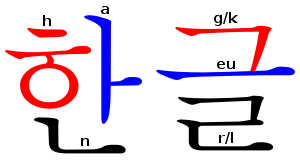
A page from the Hunmin Jeong-eum Eonhae. The Hangul-only column, third from the left (나랏말ᄊᆞ미), has pitch-accent diacritics to the left of the syllable blocks.
훈민정음
The orthography was partially standardized in 1912, with 'ㆍ(arae a)' , which is one of the vowels in early hangul and is not used in modern hangul, restricted to Sino-Korean, the emphatic consonants written ㅺ sg, ㅼ sd,ㅽ sb, ㅆ ss, ㅾ sj, and final consonants restricted to ㄱ g, ㄴ n, ㄹ l, ㅁ m, ㅂ b, ㅅ s, ㅇ ng, ㄺ lg, ㄻ lm, ㄼ lb (no ㄷ d, as it was replaced by s). Long vowels were marked by a diacritic dot to the left of the syllable, but this was dropped in 1921.[9]
A second colonial reform occurred in 1930. Arae a was abolished; the emphatic consonants were changed to ㄲ gg, ㄸ dd,ㅃ bb, ㅆ ss, ㅉ jj; more final consonants (ㄷㅈㅌㅊㅍㄲㄳㄵㄾㄿㅄ) were allowed, making the orthography moremorphophonemic; ㅆ ss was written alone (without a vowel) when it occurred between nouns; and the nominative particle 가 ga was introduced after vowels, replacing ㅣ i. (ㅣ i had been written without an ㅇ iung. The nominative particle had been unvarying i in Sejong's day, and perhaps up to the eighteenth or nineteenth century.)[9]
In addition, there are numerous obsolete letters, as well as a number of sequences which are no longer used. Some of these were only ever used for transcribing Chinese.
- 13 obsolete consonants: ᄛ, ㅱ, ㅸ, ᄼ, ᄾ, ㅿ, ㆁ (as distinct from ㅇ), ᅎ, ᅐ, ᅔ, ᅕ, ㆄ, ㆆ
- 10 obsolete double consonants: ㅥ, ᄙ, ㅹ, ᄽ, ᄿ, ᅇ, ᇮ, ᅏ, ᅑ, ㆅ
- 66 obsolete clusters of two consonants: ᇃ, ᄓ, ㅦ, ᄖ, ㅧ, ㅨ, ᇉ, ᄗ, ᇋ, ᄘ, ㅪ, ㅬ, ᇘ, ㅭ, ᇚ, ᇛ, ㅮ, ㅯ, ㅰ, ᇠ, ᇡ, ㅲ, ᄟ, ㅳ, ᇣ, ㅶ, ᄨ, ㅷ, ᄪ, ᇥ, ㅺ, ㅻ, ㅼ, ᄰ, ᄱ, ㅽ, ᄵ, ㅾ, ᄷ, ᄸ, ᄹ, ᄺ, ᄻ, ᅁ, ᅂ, ᅃ, ᅄ, ᅅ, ᅆ, ᅈ, ᅉ, ᅊ, ᅋ, ᇬ, ᇭ, ㆂ, ㆃ, ᇯ, ᅍ, ᅒ, ᅓ, ᅖ, ᇵ, ᇶ, ᇷ, ᇸ,
- and 17 of three consonants: ᇄ, ㅩ, ᇏ, ᇑ, ᇒ, ㅫ, ᇔ, ᇕ, ᇖ, ᇞ, ㅴ, ㅵ, ᄤ, ᄥ, ᄦ, ᄳ, ᄴ.
- 1 obsolete vowel: ㆍ arae-a ('sub-a'; still used in the Jeju dialect and sometimes as a substitute for ㅏ a in logos and advertizements)
- 44 obsolete diphthongs and vowel sequences: ᆜ, ᆝ, ᆢ,[are these iotized vowels?] ᅷ, ᅸ, ᅹ, ᅺ, ᅻ, ᅼ, ᅽ, ᅾ, ᅿ, ᆀ, ᆁ, ᆂ, ᆃ, ㆇ, ㆈ, ᆆ, ᆇ, ㆉ, ᆉ, ᆊ, ᆋ, ᆌ, ᆍ, ᆎ, ᆏ, ᆐ, ㆊ, ㆋ, ᆓ, ㆌ, ᆕ, ᆖ, ᆗ, ᆘ, ᆙ, ᆚ, ᆛ, ᆟ, ᆠ, ㆎ
Hangul letters and digraphs are called jamo (자모; 字母) or natsori (낱소리).[nb 3] There are 24 letters and 27 digraphs (and sometimes trigraphs) formed from these letters in the modern alphabet. Of the letters, fourteen are consonants (ja-eum 자음, 子音 "child sounds") and ten are vowels (mo-eum모음, 母音 "mother sounds"). Five of the consonants are doubled to form the five "tense" (faucalized) consonants of Korean (see below), while another eleven sequences are formed of two different consonants. The ten vowel letters are combined into eleven sequences for diphthongs.
The following letters and clusters of letters are found in the modern script:
- 14 consonant letters: ㄱ g, ㄴ n, ㄷ d, ㄹ l/r, ㅁ m, ㅂ b, ㅅ s, ㅇ null/ng, ㅈj, ㅊ ch, ㅋ k, ㅌ t, ㅍ p, ㅎ h
- 5 double ("tense") consonants: ㄲ kk, ㄸ tt, ㅃ pp, ㅆ ss, ㅉ jj
- 11 consonant clusters: ㄳ gs, ㄵ nj, ㄶ nh, ㄺ lg, ㄻ lm, ㄼ lb, ㄽ ls, ㄾ lt, ㄿlp, ㅀ lh, ㅄ bs
- 6 vowel letters: ㅏ a, ㅓ eo, ㅗ o, ㅜ u, ㅡ eu, ㅣ i
- 4 iotized vowels (with a y): ㅑ ya, ㅕ yeo, ㅛ yo, ㅠ yu
- 5 (iotized) diphthongs: ㅐ ae, ㅒ yae, ㅔ e, ㅖ ye, ㅢ ui
- 6 vowels and diphthongs with a w: ㅘ wa, ㅙ wae, ㅚ oe, ㅝ wo, ㅞ we, ㅟwi
For instance, the consonant ㅌ t [tʰ] is composed of three strokes, each one meaningful: the top stroke indicates ㅌ is a plosive, like ㆆ ’, ㄱ g, ㄷ d, ㅈ j, which have the same stroke (the last is an affricate, a plosive–fricative sequence); the middle stroke indicates that ㅌ is aspirated, like ㅎ h, ㅋ k, ㅊ ch, which also have this stroke; and the curved bottom stroke indicates that ㅌ is alveolar, like ㄴ n, ㄷ d, and ㄹ l. (This element is said to represent the shape of the tongue when pronouncing coronal consonants, though this is not certain.) Two consonants, ㆁ and ㅱ, have dual pronunciations, and appear to be composed of two elements corresponding to these two pronunciations: [ŋ]~silence for ㆁ and [m]~[w] for obsolete ㅱ.
With vowel letters, a short stroke connected to the main line of the letter indicates that this is one of the vowels that can be iotated; this stroke is then doubled when the vowel is iotated. The position of the stroke indicates which harmonic class the vowel belongs to, "light" (top or right) or "dark" (bottom or left). In the modern alphabet, an additional vertical stroke indicates i-mutation, deriving ㅐ [ɛ], ㅔ [e], ㅚ [ø], and ㅟ [y] from ㅏ [a], ㅓ [ʌ], ㅗ [o], and ㅜ [u]. However, this is not part of the intentional design of the script, but rather a natural development from what were originally diphthongs ending in the vowel ㅣ [i].
The consonant letters fall into five homorganic groups, each with a basic shape, and one or more letters derived from this shape by means of additional strokes. In the Hunmin Jeong-eum Haerye account, the basic shapes iconically represent the articulations the tongue, palate, teeth, and throat take when making these sounds.
| Simple | Aspirated | Tense | |
|---|---|---|---|
| palatal | ㅈ | ㅊ | ㅉ |
| velar | ㄱ | ㅋ | ㄲ |
| coronal | ㄷ | ㅌ | ㄸ |
| bilabial | ㅂ | ㅍ | ㅃ |
| fricatives | ㅅ | ㅆ |
The Korean names for the groups are taken from Chinese phonetics:
- Velar consonants (아음, 牙音 a-eum "molar sounds")
- ㄱ g [k], ㅋ k [kʰ]
- Basic shape: ㄱ is a side view of the back of the tongue raised toward the velum (soft palate). (For illustration, access the external link below.) ㅋ is derived from ㄱ with a stroke for the burst of aspiration.
- Coronal consonants (설음, 舌音 seoreum "lingual sounds"):
- ㄴ n [n], ㄷ d [t], ㅌ t [tʰ], ㄹ r [ɾ, l]
- Basic shape: ㄴ is a side view of the tip of the tongue raised toward the alveolar ridge (gum ridge). The letters derived from ㄴ are pronounced with the same basic articulation. The line topping ㄷ represents firm contact with the roof of the mouth. The middle stroke of ㅌ represents the burst of aspiration. The top of ㄹ represents a flap of the tongue.
- Bilabial consonants (순음, 唇音 suneum "labial sounds"):
- ㅁ m [m], ㅂ b [p], ㅍ p [pʰ]
- Basic shape: ㅁ represents the outline of the lips in contact with each other. The top of ㅂ represents the release burst of the b. The top stroke of ㅍ is for the burst of aspiration.
- Sibilant consonants (치음, 齒音 chieum "dental sounds"):
- ㅅ s [s], ㅈ z/j [tɕ], ㅊ ch [tɕʰ]
- Basic shape: ㅅ was originally shaped like a wedge ʌ, without the serif on top. It represents a side view of the teeth. The line topping ㅈ represents firm contact with the roof of the mouth. The stroke topping ㅊ represents an additional burst of aspiration.
- Dorsal consonants (후음, 喉音 hueum "throat sounds"):
- ㅇ ng [ʔ, ŋ], ㅎ h [h]
- Basic shape: ㅇ is an outline of the throat. Originally ㅇ was two letters, a simple circle for silence (null consonant), and a circle topped by a vertical line, ㆁ, for the nasal ng. A now obsolete letter, ㆆ, represented a glottal stop, which is pronounced in the throat and had closure represented by the top line, like ㄱㄷㅈ. Derived from ㆆ is ㅎ, in which the extra stroke represents a burst of aspiration.
Vowel design[edit]
Vowel letters are based on three elements:
- A horizontal line representing the flat Earth, the essence of yin.
- A point for the Sun in the heavens, the essence of yang. (This becomes a short stroke when written with a brush.)
- A vertical line for the upright Human, the neutral mediator between the Heaven and Earth.
Short strokes (dots in the earliest documents) were added to these three basic elements to derive the vowel letter:
- Simple vowels
- Horizontal letters: these are mid-high back vowels.
- bright ㅗ o
- dark ㅜ u
- neutral ㅡ eu (ŭ)
- Vertical letters: these were once low vowels.
- bright ㅏ a
- dark ㅓ eo (ŏ)
- neutral ㅣ i
- Compound vowels
- Hangul never had a w, except for Sino-Korean etymology. Since an o or u before an a or eo became a [w] sound, and[w] occurred nowhere else, [w] could always be analyzed as a phonemic o or u, and no letter for [w] was needed. However, vowel harmony is observed: "dark" ㅜ u with "dark" ㅓ eo for ㅝ wo; "bright" ㅗ o with "bright ㅏ a for ㅘ wa:
- ㅘ wa = ㅗ o + ㅏ a
- ㅝ wo = ㅜ u + ㅓ eo
- ㅙ wae = ㅗ o + ㅐ ae
- ㅞ we = ㅜ u + ㅔ e
The compound vowels ending in ㅣ i were originally diphthongs. However, several have since evolved into pure vowels:
- ㅐ ae = ㅏ a + ㅣ i
- ㅔ e = ㅓ eo + ㅣ i
- ㅙ wae = ㅘ wa + ㅣ i
- ㅚ oe = ㅗ o + ㅣ i (formerly pronounced [ø], see Korean phonology)
- ㅞ we = ㅝ wo + ㅣ i
- ㅟ wi = ㅜ u + ㅣ i (formerly pronounced [y], see Korean phonology)
- ㅢ ui = ㅡ eu + ㅣ i
- Iotized vowels
- There is no letter for y. Instead, this sound is indicated by doubling the stroke attached to the base line of the vowel letter. Of the seven basic vowels, four could be preceded by a y sound, and these four were written as a dot next to a line. (Through the influence of Chinese calligraphy, the dots soon became connected to the line: ㅓㅏㅜㅗ.) A preceding y sound, called "iotation", was indicated by doubling this dot: ㅕㅑㅠㅛ yeo, ya, yu, yo. The three vowels that could not be iotated were written with a single stroke: ㅡㆍㅣ eu, (arae a), i.
| Simple | Iotized |
|---|---|
| ㅏ | ㅑ |
| ㅓ | ㅕ |
| ㅗ | ㅛ |
| ㅜ | ㅠ |
| ㅡ | |
| ㅣ |
The simple iotated vowels are,
- ㅑ ya from ㅏ a
- ㅕ yeo from ㅓ eo
- ㅛ yo from ㅗ o
- ㅠ yu from ㅜ u
There are also two iotated diphthongs,
- ㅒ yae from ㅐ ae
- ㅖ ye from ㅔ e
The Korean language of the 15th century had vowel harmony to a greater extent than it does today. Vowels in grammaticalmorphemes changed according to their environment, falling into groups that "harmonized" with each other. This affected the morphology of the language, and Korean phonology described it in terms of yin and yang: If a root word had yang('bright') vowels, then most suffixes attached to it also had to have yang vowels; conversely, if the root had yin ('dark') vowels, the suffixes needed to be yin as well. There was a third harmonic group called "mediating" ('neutral' in Western terminology) that could coexist with either yin or yang vowels.
The Korean neutral vowel was ㅣ i. The yin vowels were ㅡㅜㅓ eu, u, eo; the dots are in the yin directions of 'down' and 'left'. The yang vowels were ㆍㅗㅏ ə, o, a, with the dots in the yang directions of 'up' and 'right'. The Hunmin Jeong-eum Haerye states that the shapes of the non-dotted letters ㅡㆍㅣ were chosen to represent the concepts of yin, yang, and mediation: Earth, Heaven, and Human. (The letter ㆍ ə is now obsolete except in the Jeju dialect.)
There was yet a third parameter in designing the vowel letters, namely, choosing ㅡ as the graphic base of ㅜ and ㅗ, and ㅣ as the graphic base of ㅓ and ㅏ. A full understanding of what these horizontal and vertical groups had in common would require knowing the exact sound values these vowels had in the 15th century.
Our uncertainty is primarily with the three letters ㆍㅓㅏ. Some linguists reconstruct these as *a, *ɤ, *e, respectively; others as *ə, *e, *a. A third reconstruction is to make them all middle vowels as *ʌ, *ɤ, *a.[30] With the third reconstruction, Middle Korean vowels actually line up in a tidy vowel harmony pattern, albeit with only one front vowel and four middle vowels:
| ㅣ *i | ㅡ *ɯ | ㅜ *u |
| ㅓ *ɤ | ||
| ㆍ *ʌ | ㅗ *o | |
| ㅏ *a |
However, the horizontal letters ㅡㅜㅗ eu, u, o do all appear to have been mid to high back vowels, [*ɯ, *u, *o], and thus to have formed a coherent group phonetically in every reconstruction.
Traditional account[edit]
See also: Origin of hangul
The generally accepted account[nb 4][31] on the design of the letters is that the vowels are derived from various combinations of the following three components: ㆍ ㅡ ㅣ. Here, ㆍ symbolically stands for the (sun in) heaven, ㅡ stands for the (flat) earth, and ㅣ stands for an (upright) human. The original sequence of the Korean vowels, as stated inHunminjeongeum, listed these three vowels first, followed by a various combinations. Thus, the original order for the vowels was: ㆍ ㅡ ㅣ ㅗ ㅏ ㅜ ㅓ ㅛ ㅑ ㅠ ㅕ. Note that two positive vowels (ㅗ ㅏ) including one ㆍ are followed by two negative vowels including one ㆍ, then by two positive vowels each including two of ㆍ, and then by two negative vowels each including two of ㆍ.
The same theory provides the most simple explanation of the shapes of the consonants as approximation of the shapes of the most representative organ needed to form that sound. The original order of the consonants in Hunmin Jeong-eum was: ㄱ ㅋ ㆁ ㄷ ㅌ ㄴ ㅂ ㅍ ㅁ ㅈ ㅊ ㅅ ㆆ ㅎ ㅇ ㄹ ㅿ.
ㄱ representing the "g" sound geometrically describes a tongue just before the moment of pronunciation as the tongue blocks the passage of air.
ㅋ representing the "k" sound is derived from ㄱ by adding another stroke.
ㆁ representing the "ŋ" sound may have been derived from ㅇ by addition of a stroke.
ㄷ representing the "d" sound is derived from ㄴ by addition of a stroke.
ㅌ representing the "t" sound is derived from ㄷ by adding another stroke.
ㄴ representing the "n" sound geometrically describes a tongue making contact with an upper palate just before making the "n" sound.
ㅂ representing the "b" sound is derived from ㅁ by adding strokes.
ㅍ representing the "p" sound is a variant of ㅂ, which is obtained by a 90 degree rotation and extension the horizontal strokes.
ㅁ representing the "m" sound geometrically describes a closed mouth before opening the lips.
ㅈ representing the "dʒ" sound is derived from the shape of ㅅ by adding strokes.
ㅊ representing the "ch" sound is derived from ㅈ by adding another stroke.
ㅅ representing the "s" sound geometrically describes a near contact between the tongue and the teeth.[citation needed]
ㆆ representing a weak "h" sound geometrically describes an open throat with a bar to indicate that there is an aspiration.
ㅎ representing the "h" sound is derived from ㆆ with the extra stroke representing a stronger flow of the aspiration.
ㅇ representing the absence of a consonant geometrically describes an open mouth, which necessarily accompanies the following vowel.
ㄹ representing a sound between "r" and "l" geometrically describes a backward-bending tongue.
ㅿ representing a weak "s" sound is also derived from the shape of the teeth, but has a different origin than ㅅ[clarification needed] and is not derived from ㅅ by addition of a stroke.
Ledyard's theory of consonant design[edit]
Although the Hunmin Jeong-eum Haerye explains the design of the consonantal letters in terms of articulatory phonetics, as a purely innovative creation, there are several theories as to which external sources may have inspired or influenced King Sejong's creation. Professor Gari Ledyard of Columbia University studied on possible connections between Hangul and the Mongol Phagspa script of the Yuan dynasty. He believed that the role of Phags-pa script in the creation of Hangul was quite limited:
It should be clear to any reader that in the total picture, that [Phagspa script's] role was quite limited ... Nothing would disturb me more, after this study is published, than to discover in a work on the history of writing a statement like the following: "According to recent investigations, the Korean alphabet was derived from the Mongol 'phags-pa script..."[32]
Ledyard posits that five of the Hangul letters have shapes inspired by Phags-pa; a sixth basic letter, the null initial ㅇ, was invented by Sejong. The rest of the letters were derived internally from these six, essentially as described in theHunmin Jeong-eum Haerye. However, the five borrowed consonants were not the graphically simplest letters considered basic by the Hunmin Jeong-eum Haerye, but instead the consonants basic to Chinese phonology: ㄱ, ㄷ, ㅂ, ㅈ, and ㄹ.
The Hunmin Jeong-eum states that King Sejong adapted the 古篆 ("Gǔ Seal Script") in creating Hangul. The 古篆 has never been identified. The primary meaning of 古 gǔ is "old" ("Old Seal Script"), frustrating philologists because Hangul bears no functional similarity to Chinese 篆字 seal scripts. However, Ledyard believes 古 gǔ may be a pun on 蒙古 Měnggǔ "Mongol", and that 古篆 is an abbreviation of 蒙古篆字 "Mongol Seal Script", that is, the formal variant of the Phagspa alphabet written to look like the Chinese seal script. There were Phagspa manuscripts in the Korean palace library, including some in the seal-script form, and several of Sejong's ministers knew the script well.
If this was the case, Sejong's evasion on the Mongol connection can be understood in light of Korea's relationship with Ming China after the fall of the Mongol Yuan dynasty, and of the literati's contempt for the Mongols as "barbarians".
According to Ledyard, the five borrowed letters were graphically simplified, which allowed for consonant clusters and left room to add a stroke to derive the aspirate plosives, ㅋㅌㅍㅊ. But in contrast to the traditional account, the non-plosives (ng ㄴㅁ and ㅅ) were derived by removing the top of the basic letters. He points out that while it's easy to derive ㅁ from ㅂ by removing the top, it's not clear how to derive ㅂ from ㅁ in the traditional account, since the shape of ㅂ is not analogous to those of the other plosives.
The explanation of the letter ng also differs from the traditional account. Many Chinese words began with ng, but by King Sejong's day, initial ng was either silent or pronounced [ŋ] in China, and was silent when these words were borrowed into Korean. Also, the expected shape of ng (the short vertical line left by removing the top stroke of ㄱ) would have looked almost identical to the vowel ㅣ [i]. Sejong's solution solved both problems: The vertical stroke left from ㄱ was added to the null symbol ㅇ to create ㆁ (a circle with a vertical line on top), iconically capturing both the pronunciation [ŋ] in the middle or end of a word, and the usual silence at the beginning. (The graphic distinction between null ㅇ and eng ㆁ was eventually lost.)
Another letter composed of two elements to represent two regional pronunciations was ㅱ, which transcribed the Chineseinitial 微. This represented either m or w in various Chinese dialects, and was composed of ㅁ [m] plus ㅇ (from Phagspa [w]). In Phagspa, a loop under a letter represented w after vowels, and Ledyard proposes this became the loop at the bottom of ㅱ. Now, in Phagspa the Chinese initial 微 is also transcribed as a compound with w, but in its case the w is placed under an h. Actually, the Chinese consonant series 微非敷 w, v, f is transcribed in Phagspa by the addition of a wunder three graphic variants of the letter for h, and Hangul parallels this convention by adding the w loop to the labial series ㅁㅂㅍ m, b, p, producing now-obsolete ㅱㅸㆄ w, v, f. (Phonetic values in Korean are uncertain, as these consonants were only used to transcribe Chinese.)
As a final piece of evidence, Ledyard notes that most of the borrowed Hangul letters were simple geometric shapes, at least originally, but that ㄷ d [t] always had a small lip protruding from the upper left corner, just as the Phagspa d [t] did. This lip can be traced back to the Tibetan letter d, ད.
